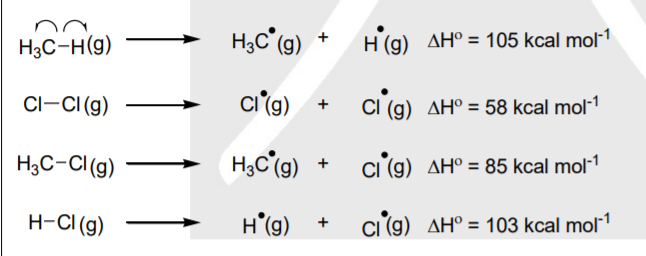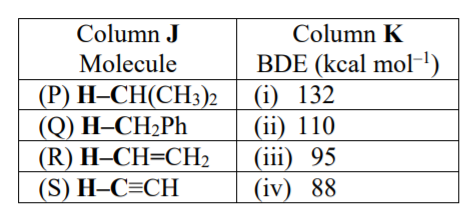THE BREAKING OF BONDS-HOMOLYTIC AND HETEROLYTIC CLEAVAGE
Step by step video & image solution for THE BREAKING OF BONDS-HOMOLYTIC AND HETEROLYTIC CLEAVAGE by Chemistry experts to help you in doubts & scoring excellent marks in Class 11 exams.
Updated on:21/07/2023Similar Questions
Knowledge Check
Reactivity of alcohol in breaking O-H bond is
A1∘>2∘>3∘B3∘>2∘>1∘C2∘>1∘>3∘D1∘>3∘>2∘
Describe heterolytic (polar) bond cleavage of :
(i) Agl,
(ii) H3⊕NӨBF3,
(iii) [Cu(OH2)4]2⊕
(b) Name the reverse of heterolytic cleavage.
( c) Describe homolytic bond cleavage of CH3−Co−Co−CH3.
(d) Compare the relative energies of singlet and triplet carbenes.
( e) Of XC : (singlet) and X2C : (triplet), which is stable ?
(f) Of F2C:,C12C:,Br2C:,I2C: (singlet), which is more stable ?
(g) Compare and explain the difference in the IE and EA of ⋅CH3.
View SolutionTypes OF Cleavage OF Covalent Bond and Reaction || Intermediate Types
View SolutionChemical Properties|Cleavage Of C-O Bond In Ehters|Questions|Summary
View SolutionThe amount of energy required to break a bond is same as the amount of energy released when the same bond is formed. In gaseous state, the enrgy required for hololytic cleavage of a bond is called Bond Dissociation Energy(BDE) or Bond Strength. BDE is affected by s-character of the bond and the stability of the radicals formed. Shorter bonds typically stronger bonds. BDEs for some bonds are given below:

Correct match of the C-H bonds(shown in bold) in column J with their BDE in column K is
View SolutionThe amount of energy required to break a bond is same as the amount of energy released when the same bond is formed. In gaseous state, the enrgy required for hololytic cleavage of a bond is called Bond Dissociation Energy(BDE) or Bond Strength. BDE is affected by s-character of the bond and the stability of the radicals formed. Shorter bonds typically stronger bonds. BDEs for some bonds are given below:

For the following reaction
CH4(g)+Cl2(g)light−−→CH3Cl(g)+HCl(g)
the correct statement is
View SolutionII. Read the following passage and answer questions 6-10 that follow :
During organic reactions, a covalent bond between two carbon atoms or carbon atom and some other atom is broken and a new bond is formed. The fission of bonds can be homolytic or heterolytic forming free radicals, carbocations carbanions, carbenes, etc. This also depends upon the displacement, of electron in a bond and is governed by inductive effect, electromeric effect, reasonance and hyperconjugation.
Which of the two CH2=CH− or HC≡C− is a better nucleophile?
View SolutionCleavage || Classification OF Cleavage || Determinate Cleavage || Indeterminate Cleavage || Complete or Holoblastic Cleavage Meroblastic Cleavage
View Solution
